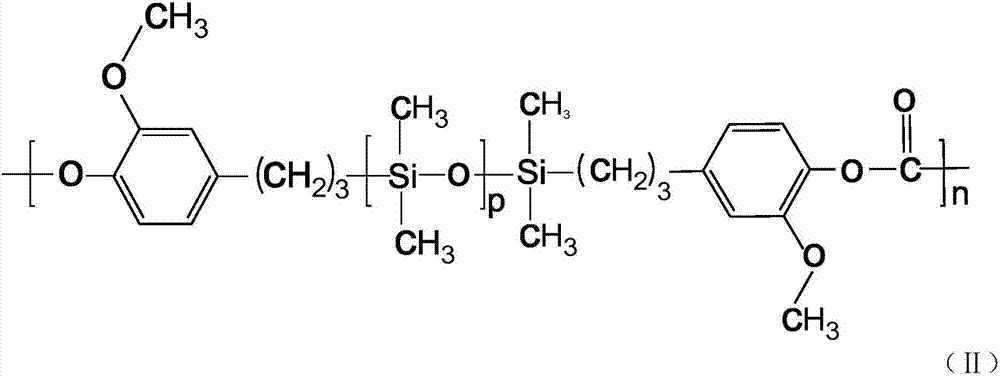Low temperature resistant non-transparent high-impact random copolymerization polycarbonate, preparation method and application thereof
A technology of polycarbonate and random copolymerization, which is applied in the field of preparing the low-temperature-resistant non-transparent high-impact random copolymer polycarbonate and low-temperature-resistant non-transparent high-impact random copolymer polycarbonate, which can solve the problem of polysiloxane The comprehensive performance of the copolymer cannot meet the requirements, the product cannot meet the practical application, and the reaction control requirements are strict, etc., to achieve the effect of promoting large-scale application, excellent comprehensive performance, and excellent comprehensive performance
- Summary
- Abstract
- Description
- Claims
- Application Information
AI Technical Summary
Problems solved by technology
Method used
Image
Examples
preparation Embodiment 1
[0049] Add 228.3kg of bisphenol A, 120kg of sodium hydroxide, and 2000kg of water to the mixer. After the bisphenol A is completely dissolved, add 324g of the catalyst tetrabutylammonium bromide to form a sodium phenolate brine phase; in another mixer Add 128.9kg of liquid phosgene and 4830L of dichloromethane, mix uniformly to form an oil phase; then put the sodium phenolate brine phase into the polymerization reactor, and then mix the oil phase and 26.4kg prepared in the preliminary example at a stirring rate of 550rpm The eugenol-terminated polysiloxane was added to the polymerization reactor at a rate of 100g / min and 150g / min, while a 10% by weight aqueous solution of sodium hydroxide was added dropwise to the reaction system to keep the pH of the reaction system at 11.4, and the temperature of the reaction system is maintained at 35°C; after 2 hours of reaction, the reaction system is separated and purified and the organic solvent is removed to obtain the random copolymer p...
preparation Embodiment 2
[0051] Add 228.3kg of bisphenol A, 145kg of sodium hydroxide, and 2300kg of water to the mixer. After the bisphenol A is completely dissolved, add 367g of the catalyst tetrabutylammonium bromide to form a sodium phenolate brine phase; in another mixer Add 130.5kg of liquid phosgene and 5417L of dichloromethane, mix uniformly to form an oil phase; then put the sodium phenolate brine phase into the polymerization reactor, and then mix the oil phase and 38.6kg prepared in the preliminary example at a stirring rate of 675 rpm The eugenol-terminated polysiloxane was added to the polymerization reactor at a rate of 120g / min and 170g / min, respectively, while a 10% by weight aqueous sodium hydroxide solution was added dropwise to the reaction system to maintain the pH of the reaction system 11.6, and the temperature of the reaction system is maintained at 40°C; after 2.5 hours of reaction, the reaction system is separated and purified and the organic solvent is removed to obtain the ran...
preparation Embodiment 3
[0053] Add 228.3kg of bisphenol A, 169kg of sodium hydroxide, and 2400kg of water to the mixer. After the bisphenol A is completely dissolved, add 415g of the catalyst tetrabutylammonium bromide to form a sodium phenolate brine phase; in another mixer Add 134.6kg of liquid phosgene and 5587L of dichloromethane, mix uniformly to form an oil phase; then put the sodium phenolate brine phase into the polymerization reactor, and then mix the oil phase and 40.8kg prepared in the preliminary example at a stirring rate of 795rpm The eugenol-terminated polysiloxane was added to the polymerization reactor at a rate of 150g / min and 180g / min, and at the same time an aqueous solution of sodium hydroxide with a concentration of 10% by weight was added dropwise to the reaction system to keep the pH of the reaction system at 11.7, and the temperature of the reaction system is maintained at 42°C; after 2.5 hours of reaction, the reaction system is separated and purified and the organic solvent i...
PUM
| Property | Measurement | Unit |
|---|---|---|
| impact strength | aaaaa | aaaaa |
| polydispersity index | aaaaa | aaaaa |
| polydispersity index | aaaaa | aaaaa |
Abstract
Description
Claims
Application Information
 Login to View More
Login to View More - R&D
- Intellectual Property
- Life Sciences
- Materials
- Tech Scout
- Unparalleled Data Quality
- Higher Quality Content
- 60% Fewer Hallucinations
Browse by: Latest US Patents, China's latest patents, Technical Efficacy Thesaurus, Application Domain, Technology Topic, Popular Technical Reports.
© 2025 PatSnap. All rights reserved.Legal|Privacy policy|Modern Slavery Act Transparency Statement|Sitemap|About US| Contact US: help@patsnap.com



